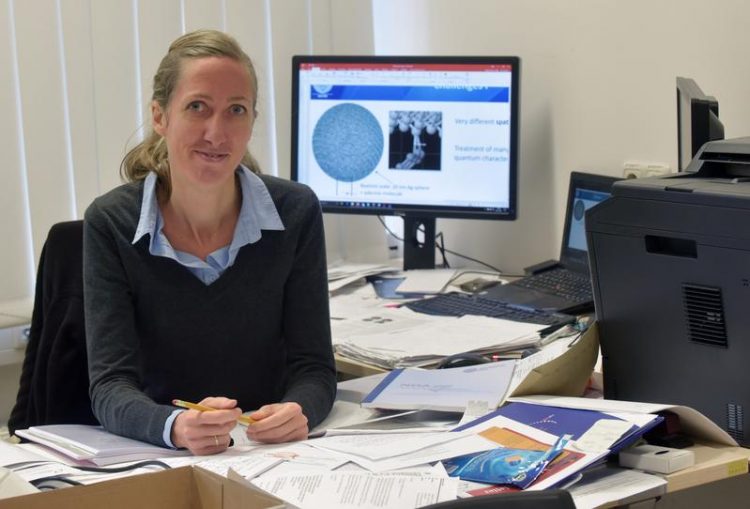From quasiparticles to highly sensitive sensors

The Jena chemist Prof. Dr Stefanie Gräfe has been awarded an "ERC Grant". This allows her to deal with ultrafast time- and space-resolved dynamics in molecular-plasmonic hybrid systems. (Photo: Jan-Peter Kasper/FSU)
For those who want to clarify fundamental questions in science to develop new theories, not only perseverance also funding is essential. The EU may not be able to present one with time, however, its European Research Council (ERC) may provide one with one of its most substantial awards: the ERC Consolidator Grant. Recently, one has also been awarded to Prof. Dr Stefanie Gräfe from the Friedrich Schiller University Jena, Germany.
After the grant had already been awarded to three male Jena researchers, the Professor of Theoretical Chemistry is the first woman at the University who received this rare research funding award. Prof. Gräfe plans to invest the around €1,9 million funding in eight new positions for young researchers in the research area of non-linear optics.
Dealing with ultrafast time- and space-resolved dynamics in molecular-plasmonic hybrid systems, her project QUEM-CHEM is to provide fundamentals and new theories in the next five years in order to subsequently be able to develop potential applications, for instance in highly sensitive sensors. ‘Having received this grant, I now have a chance to carry out the project which I have been striving for a long time,’ says the 38-year-old researcher from Jena who aims at marrying electromagnetism with quantum mechanics.
What happens on a metal-molecule system when light shines on it?
If light shines on matter, it induces interactions. In case of metallic nanoparticles this leads to a fluctuation of the density of charge carriers – among physicist this phenomenon is known as plasmonic quasiparticles. Consequently, light is enhanced: the smaller the nanoparticles are, the more amplified the light may be. In the new project QUEM-CHEM, Stefanie Gräfe and her team want to carry out research into nano-related fundamental questions, in particular, investigate what happens on the interface of metallic solids and molecules after light interaction.
‘There has not been any sound theory about it, yet,’ explains the expert decided to develop one. The research in Gräfe’s research group will focus on computer simulation first. Their aim is to calculate the plasmonic dynamics, i.e. light-induced movements of electrons in metal. In addition, by applying quantum-chemical methods, the molecular structure will be calculated.
Last but not least, both rather different methods should be combined. As a result, chemical reaction mechanisms of light and metallic molecular systems may be clarified. The Jena researcher plans a cooperation with the related experimental research group under Prof. Dr Volker Deckert to be able to compare the theory developed with practice.
Examine snails and rockets all in one
Regarding the whole project, it is not only the extremely variable spatial dimensions complicating it – the reactions have variable speeds, too. ‘We have to examine snails and rockets all in one,’ demonstrates Prof. Gräfe the approach pointing out that, at the end, a price-performance ratio should prevail. When applying the new findings, the point is also to develop something that may function beyond laboratory-specific conditions, something that may also be used for other basic research and applied research.
In anticipation of being able to detect and classify chiral molecules – as they are characteristic of Contergan – in five years, Prof. Gräfe already bursts with ideas on possible applications, for example in spectroscopy, biophotonics and nanophotonics, and in research on sensors.
She is firmly convinced that these visions may come true: ‘We have already carried out studies into this area successfully. Having received the ERC Grant, I can start the research with additional personnel support’, she is delighted with the EU grant.
The ERC Grants
The ERC Consolidator Grants are meant for outstanding, young researchers who produce distinctive publications after having finished their doctorate and have conceived a risky but potentially high-impact research proposal. For their projects, selected researchers may be awarded up to €2 million for a period of up to five years.
Contact:
Prof. Dr Stefanie Gräfe
Institute of Physical Chemistry at the Friedrich Schiller University Jena
Helmholtzweg 4, 07743 Jena, Germany
Phone: +49 (0) 3641 / 948330
Email: s.graefe[at]uni-jena.de
Media Contact
All latest news from the category: Awards Funding
Newest articles

Webb captures top of iconic horsehead nebula in unprecedented detail
NASA’s James Webb Space Telescope has captured the sharpest infrared images to date of a zoomed-in portion of one of the most distinctive objects in our skies, the Horsehead Nebula….

Cost-effective, high-capacity, and cyclable lithium-ion battery cathodes
Charge-recharge cycling of lithium-superrich iron oxide, a cost-effective and high-capacity cathode for new-generation lithium-ion batteries, can be greatly improved by doping with readily available mineral elements. The energy capacity and…

Novel genetic plant regeneration approach
…without the application of phytohormones. Researchers develop a novel plant regeneration approach by modulating the expression of genes that control plant cell differentiation. For ages now, plants have been the…





















